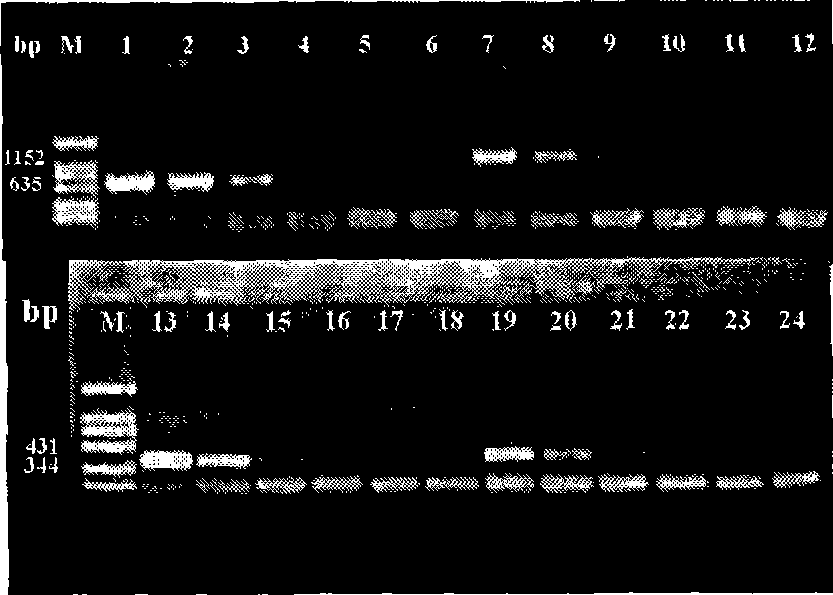Corn and composite PCR detecting method of fumonisin toxigenic strain in corn products
A detection method and hummus technology are applied in the field of crop disease prevention and phytosanitary, which can solve the problems of not directly revealing the toxigenicity of the strain to be tested, and not completely guaranteeing the reliability of the results, saving detection time, improving accuracy, The effect of high detection accuracy
- Summary
- Abstract
- Description
- Claims
- Application Information
AI Technical Summary
Problems solved by technology
Method used
Image
Examples
Embodiment 1
[0038] Example 1 Isolation of bacterial strains on unprocessed corn kernels and detection of fumonisin toxin-producing strains
[0039] The unprocessed corn cobs and kernels used in this experiment were collected from all over the country, a total of 44 samples. Among them, 1 in North China (3 in Inner Mongolia, 1 in Hebei, 2 in Shanxi), 7 in Northwest China (Shaanxi), 1 in Northeast China (4 in Heilongjiang, 1 in Liaoning, 2 in Jilin), 15 in North and Central China (9 in Shandong, 6 in Henan), and 9 in Jiangnan (2 in Jiangsu, 2 in Zhejiang, and 5 in Shanghai).
[0040] Step 1: Primer Synthesis
[0041] The designed primer sequences of the present invention (see Table 1)
[0042] Table 1 PCR primers designed in the present invention
[0043]
[0044] ** Bluhm, 2002.
[0045] Submit to Shanghai Sangon Bioengineering Technology Service Company for synthesis. 1 OD U260 per tube, stock solution concentration 25 μmol / L, prepared with sterile double distilled water. Store ...
Embodiment 2
[0078] Example 2 Direct detection of fumonisin-producing strains on unprocessed corn kernels
[0079] The materials used in this experiment are the same as in Example 1.
[0080] Step 1: Primer Synthesis
[0081] The operation steps are the same as the first step of embodiment 1.
[0082] Step 2: Template DNA Extraction
[0083] Grind the corn kernels into powder, and put about 0.2g into a 50ml test tube. Add 4ml of DNA extraction solution and vortex to mix well. Add 2ml of phenol and 1.5ml of chloroform, vortex, and centrifuge at 2500g for 15min. Transfer the supernatant to 2ml centrifuge tubes, add 900 μl of supernatant and 900 μl of chloroform to each tube, and centrifuge at 13200 rpm for 5 minutes. Transfer the upper layer solution to a new 2ml test tube, and add RNase I (final concentration C≥100μg / ml). Then incubate at 37°C for 2-3h. Add an equal volume of cold 5M lithium chloride solution, shake gently to mix well, and place on ice for another 15 min. Centrifuge...
Embodiment 3
[0089] Example 3 Detection of processed corn products
[0090] The materials used in this experiment are corn grits, corn flour, corn cakes, quick-frozen corn cobs, etc., a total of 14 parts.
[0091] Step 1: Primer Synthesis
[0092] The operation steps are the same as the first step of embodiment 1.
[0093] Step 2: Template DNA Extraction
[0094] After the sample was ground, the template DNA was extracted according to the operation steps of the second step of Example 2.
[0095] Step 3: Multiplex PCR amplification
[0096] With the fourth step of embodiment 1.
[0097] Step 4: Judgment of test results
[0098] Same as the fifth step in Example 1.
[0099] Implementation results:
[0100] No fumonisin-producing bacteria or other strains were detected on the corn products collected in the experiment. Perhaps it is related to the source of these products. Natural products such as corn cobs and corn kernels are mostly collected from rural farmers. The storage condition...
PUM
 Login to View More
Login to View More Abstract
Description
Claims
Application Information
 Login to View More
Login to View More - R&D
- Intellectual Property
- Life Sciences
- Materials
- Tech Scout
- Unparalleled Data Quality
- Higher Quality Content
- 60% Fewer Hallucinations
Browse by: Latest US Patents, China's latest patents, Technical Efficacy Thesaurus, Application Domain, Technology Topic, Popular Technical Reports.
© 2025 PatSnap. All rights reserved.Legal|Privacy policy|Modern Slavery Act Transparency Statement|Sitemap|About US| Contact US: help@patsnap.com



